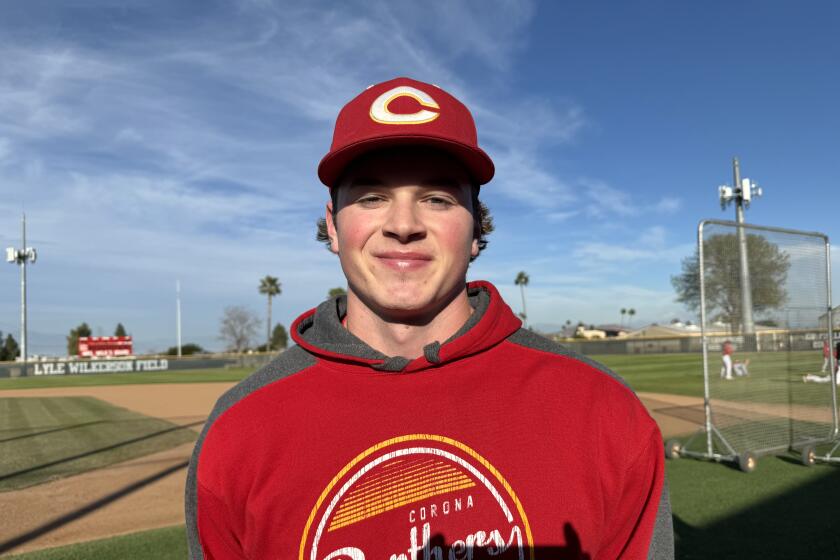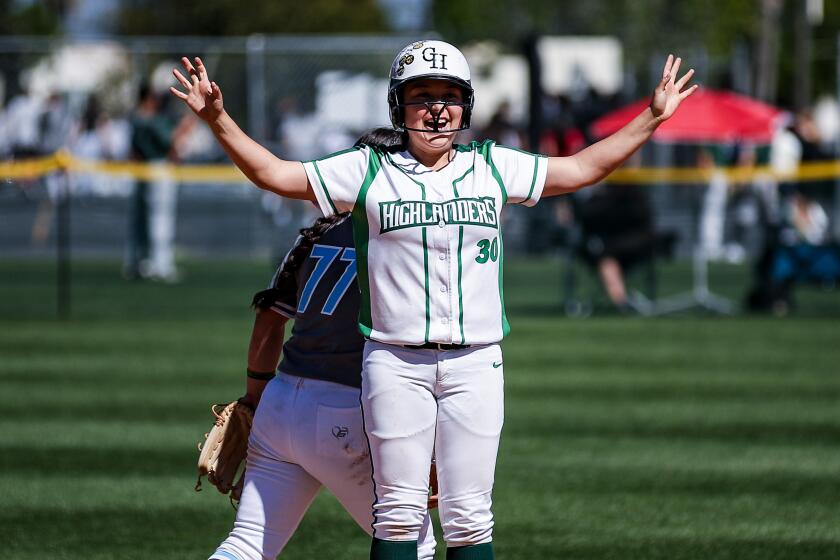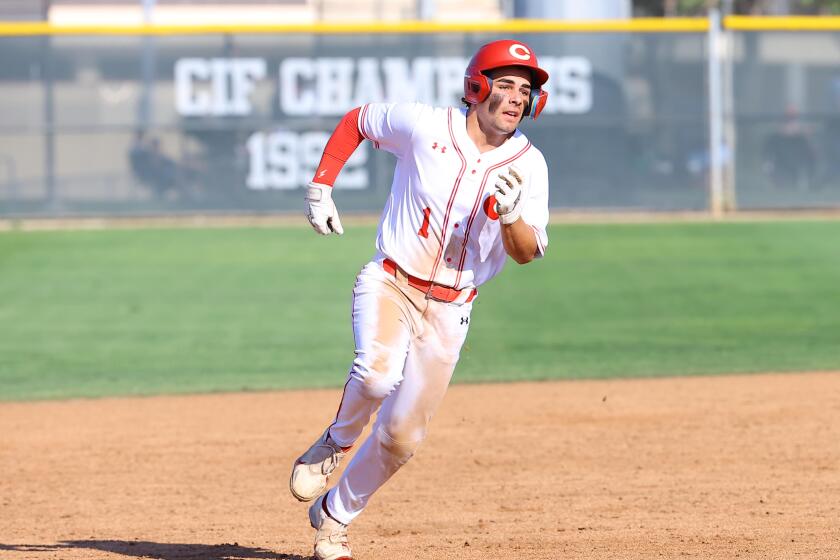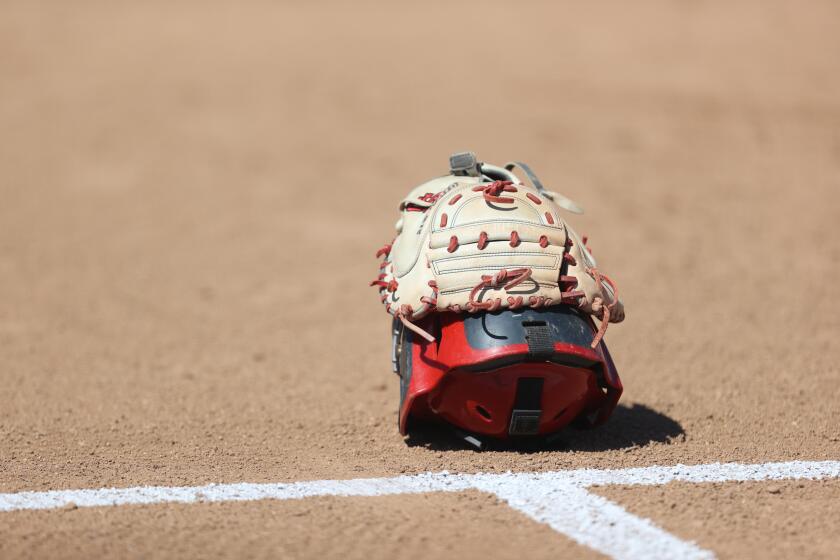Small Colleges : CCAA Is Taking Long Look at Foreign Legion
The California Collegiate Athletic Assn. likes to call itself the conference of champions, and the CCAA does win its share of Division II national titles.
Whether it’s an all-American conference is another matter.
A scan of CCAA rosters shows foreign-born players on nearly every soccer team, among them a Nigerian at Cal State Dominguez Hills and a South African at Chapman, a Sudanese at Cal Poly San Luis Obispo and a Peruvian at Cal State Bakersfield.
Bakersfield also has had good luck with foreign students on its national champion swim team. Cal State Los Angeles has a member of the Irish national track team running cross-country. The Dominguez Hills golf team calls itself the international brigade, with an Indian, a Canadian and a Korean.
Last spring, two of the conference’s best women tennis players were Edna Olivarez, the Filipina junior champion at Cal State L.A., and Xenia Anastasiadou of the Greek national team at Cal Poly Pomona.
It’s no accident that foreign athletes are turning up at small colleges. Foreign athletes 21 or older at NCAA Division I schools lose a year’s eligibility for every year of international competition they have had. There are no such limits in lower NCAA divisions or in the NAIA.
Thus, many foreign athletes who want to compete in the United States are attracted to smaller colleges. CCAA athletic directors and spokesmen said that in many cases the athletes aren’t recruited but initiate contact themselves. Often, they are students who simply join teams when they are admitted to schools.
Dennis Keihn, athletic director at Cal State L.A. and a member of an NCAA rules committee, said: “Some of our coaches have recruited to a certain degree. Some (athletes) will write a coach. It’s a combination of both. The university reserves a number of fee waivers for outstanding freshman students. That has spurred coaches to do a little bit more looking.”
Keihn and Bob Heigert, athletic director at Cal State Northridge and the current CCAA president, said there is some backlash against large numbers of foreign athletes, who are often older than their American counterparts, and who are sometimes perceived as getting aid or scholarships that would otherwise be going to American students.
On the CCAA level and below, however, there are very few full-ride scholarships, and many athletes are walk-ons or are receiving normal student aid. Some foreign students receive aid from their governments.
“The main thing (opponents) are against is the athlete who comes in at 25, competing against a U.S. freshman who’s 18 or 19,” Keihn said. “That’s quite an advantage.”
Heigert said: “At some institutions it’s easier for some to register and get in. The main concern nationally is that foreign athletes might be taking the place of an American citizen. It’s not much of a problem in competition. I don’t think the conference has a problem. There’s no mass recruiting of foreign athletes. There’s a bigger problem in championships and the NCAA tournaments. Talk to the track coaches. I know some coaches’ groups think it’s a big problem.”
Keihn and Heigert said that proposals to bring the lower NCAA divisions in line with Division I, at least the age issue, will probably come up in January meetings. “We (Northridge) certainly hope that’s the case,” Heigert said. “We’re in favor of as stringent requirements--including academics--as Division I, if not more.”
Add foreigners: Azusa Pacific has won four straight NAIA track and field titles, led by a contingent of African stars. School spokesman Gary Pine points out, however, that their accomplishments outstrip their numbers. “We had 5 (Nigerians) last year on our track team. Wayland Baptist (in Texas) had 15 to 20,” Pine said. “We’ve had a total of 9 in 5 years.”
Azusa’s Nigerian pipeline started with sprinter Innocent Egbunike five years ago. Pine said that Egbunike helps funnel athletes to the school, but that he also helps screen candidates.
“We get a lot of calls and have a lot of people inquire. The ones we take are all good students and all very well liked on campus. (Coach Terry Franson) has turned down some good athletes because Innocent said they had questionable characters. Also, he’s very conscious of what other coaches think, of not overloading.”
UC Santa Barbara’s football team came back to Earth on Saturday, losing to Humboldt State, 27-7. But Coach Mike Warren is predicting happy days for the football program that he is rebuilding after it was dropped 15 years ago. The Gauchos are 1-1 going into Saturday’s game at Pomona-Pitzer.
“UC Davis is a parallel,” Warren said. “They’re winning conference titles without scholarships. They’re winning with our kids. Those are the kids we’ll be getting here. You’ve just got to walk around campus, feel the environment. This is California living at its best. This is the jewel of the UC system. If you want the UC system and Division II football (actually, Santa Barbara is listed as Division III) would you take Sacramento or the beach?
“I don’t see any reason we can’t play with Davis, San Luis Obispo, Santa Clara. It’s an exciting time around here. The potential is unlimited.”
Warren said the new program has been helped by the hiring of Stan Morrison, former USC basketball coach, as athletic director.
“From our standpoint, he’s been around the block,” Warren said. “He’s been where football is good. He has the big picture. Stan has no limits on his thinking. He’s dynamic, optimistic. That’s the way we’ve been in trying to get this going. We’ve found a comrade.”
Get our high school sports newsletter
Prep Rally is devoted to the SoCal high school sports experience, bringing you scores, stories and a behind-the-scenes look at what makes prep sports so popular.
You may occasionally receive promotional content from the Los Angeles Times.



